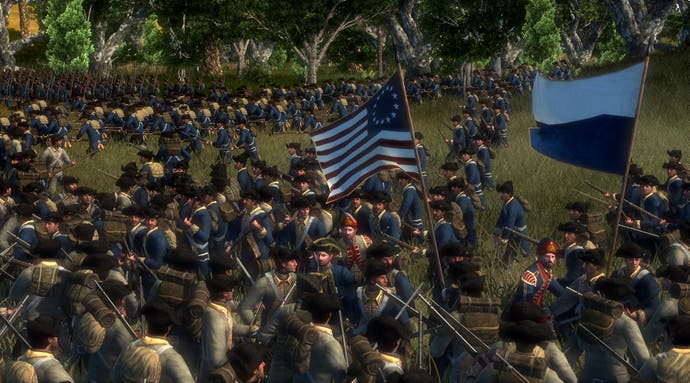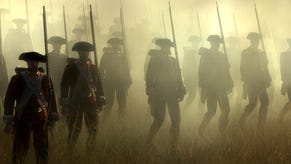Empire: Total War
Dominant.
Meaty changes have been made to the campaign map side of things, where the tile-based layout has been scrapped, allowing players to move freely over terrain. Buildings have been ripped from settlement lists and visually scattered over the surrounding land, so one look should tell you what capabilities a settlement has. Then, if you need a ship, simply click on the port and order one to be built. Upgrades can be visually picked out, too. And these upgrades are tied to another new and key area: technologies. These can be researched and applied across the board; to alter government types, build economic infrastructures, expand trade, even enhance education to speed up the research itself. Also, of course, bigger guns. Military advancements can be as intricate as permanent bayonet attachments allowing riflemen to shoot and stab, or as obvious as town-wrecking artillery.
Another obvious change, and a rather important one, is the historical period, which takes place between 1700 and 1800. Crucially this welcomes in the age of gunpowder, and its ramifications on the battlefield are enormous. Tactics become more about protecting hulking ranged guns that can batter cities in an instant. That is, of course, presuming you don't want to settle in the city - flatten it and the population will hate you, unsurprisingly, and it will need to be rebuilt. Cavalry also no longer flattens infantry, and the effect is hefty blurring of the paper, scissors, stone unit hierarchy. Empire, it's fair to say, presents an ideal more akin to paper, scissors, stone, tree, bird, apple and bucket.
Riflemen and snipers can be garrisoned or hide behind cover for the first time in the series, and there are all sorts of period tactics employed by your opposing numbers and factions. Take storming a city, as you want to settle there and increase your empire. If the defenders decide to garrison in the many houses then your advancement will be slow and bloody. Add to this a heavy downpour and terrain mashed into mud and your advance becomes even more treacherous. And morale in Empire is more prevalent than ever; men will lose belief in many more stages before fleeing, but flee they will if you make foolhardy decisions to embark on a Russian campaign in mid-winter, or stomp into the tropics during monsoon season. Historic events such as the French Revolution will also play out around you. These are not set in stone, but rather will be triggered if the conditions are right, so history can be altered. In total there are 12 playable factions at launch, with 50 out there to encounter.
All of which sounds bafflingly complex and time-consuming. Only, it isn't. Because another star feature of Empire is accessibility. Tutorials and on-screen advice have been vastly improved to ease newcomers in and returning fans back. More exciting is the extensive streamlining done to cut-down micro-management and enormously time-consuming turns. So, tax and trade are handled by a tab and split into theatres (Europe, Indies, Americas), as is diplomacy. Incidentally, gone are wandering scholars and assassins to keep an eye on. Instead, the special units have been merged into just two: Gentlemen and Rakes. The former handles diplomatic pursuits, and the latter does the underhand jobs. Gentlemen, brilliantly, can engage in duels to politely dispose of key members of opposing factions, and can enrol at foreign universities and pinch research, all in the name of study. Anyway. Armies are built through generals who recruit from nearby settlements - no longer grown all over the map and then moved to meet a leader. Even commands are streamlined so that orders are issued and then moves made, thus speeding up turn time.

Clearly lots of effort has been poured into the new engine underneath all of this, which is the most visually spectacular of a visually spectacular series so far. Little soldiers can be zoomed into and exhibit extraordinary detail (even varying faces and uniforms to other members of the unit), especially considering there can be up to 10,000 on the screen firing the same number of projectiles - themselves individual physical objects. Buildings crumble, ships creak and crack and explode, and bodies litter the battlefield as a silent reminder of the carnage witnessed. Animation has significantly improved; motion-captured cinematic actions have been applied to the units likely to get into hand-to-hand range, and generally units exist and clash much more naturally and believably than before. And, surprisingly, the minimum system requirements will be fairly low; a decent machine from two years ago should do the trick. And the engine is scalable for those that can handle the extra effects.
Perhaps the only rock left unturned is multiplayer. We were told Empire would be the "most moddable" instalment in the series when we asked if there would be a toolset shipped with the game, and there would be "more modes of [online] play" than ever before - some inspired by fans, others to attract newcomers. Creative Assembly will reveal all in the lead up to February 2009, but the feeling in the room was that something special lurks in the wings. The series has only ever let us face off in land battles against each other online. Perhaps Empire will finally gift the Total War series with an online campaign map mode. We certainly hope so. If it does, then there is so much both at first glance and second that Empire may do what no other in the series has: earn 10/10.







.png?width=291&height=164&fit=crop&quality=80&format=jpg&auto=webp)



